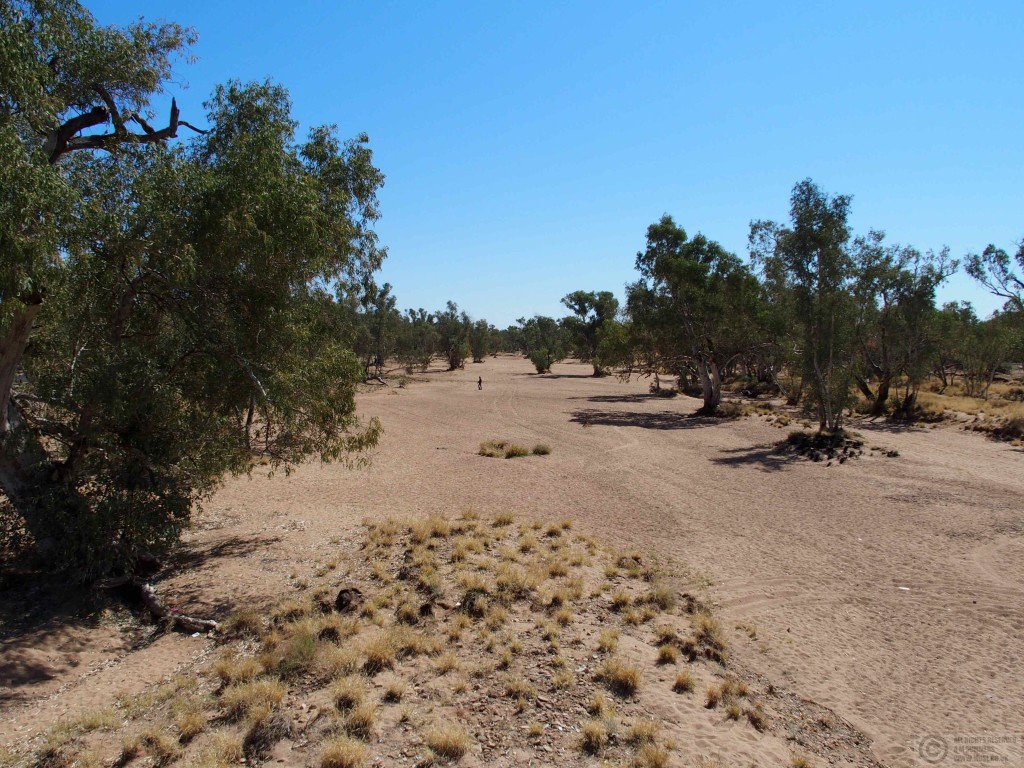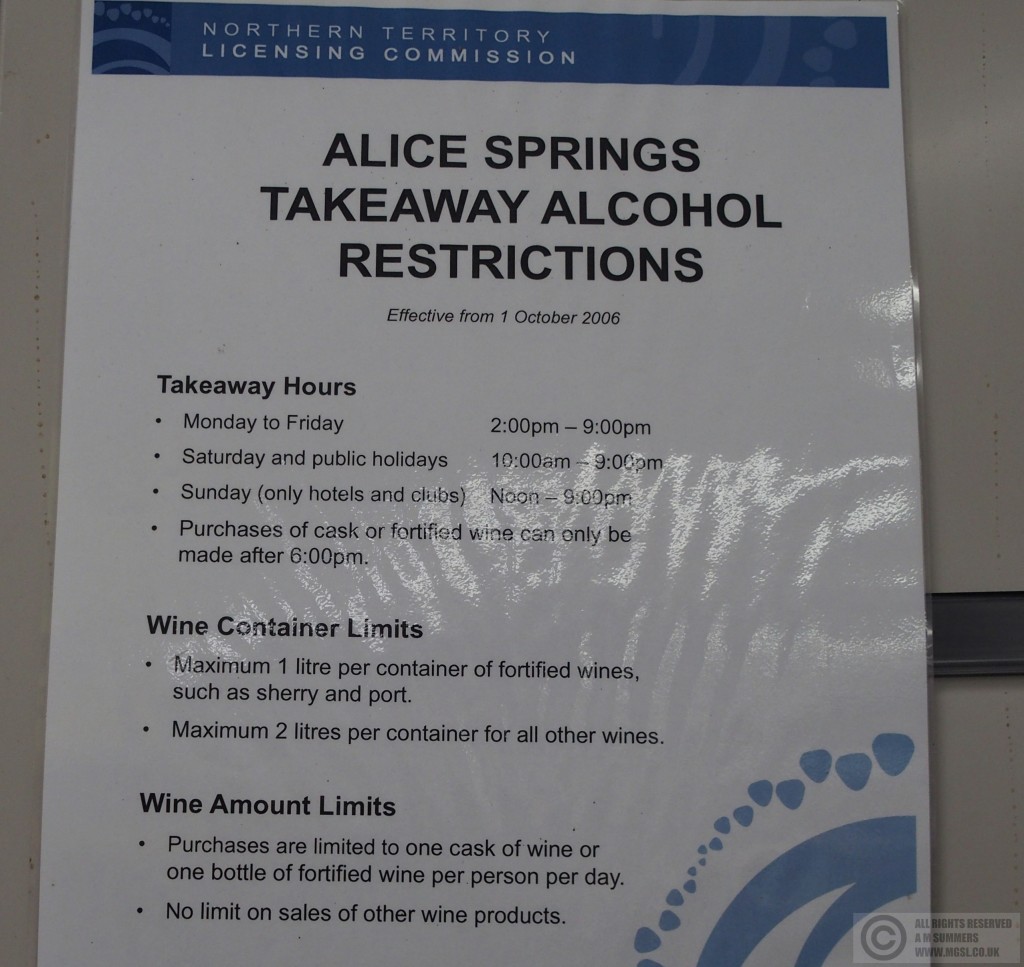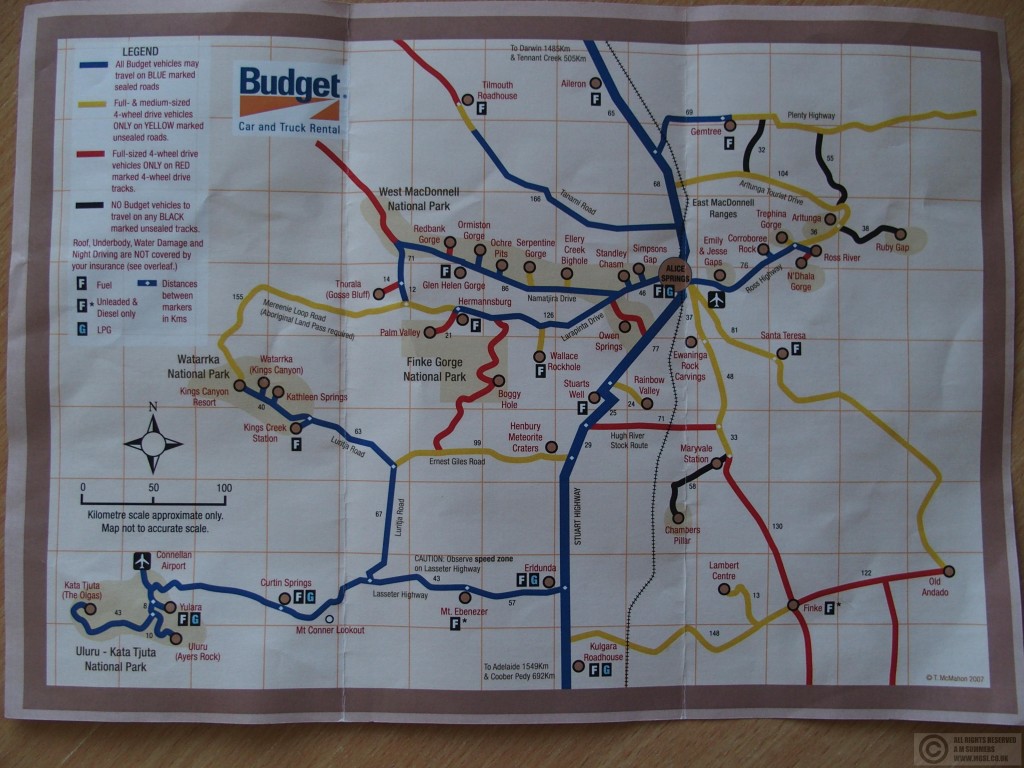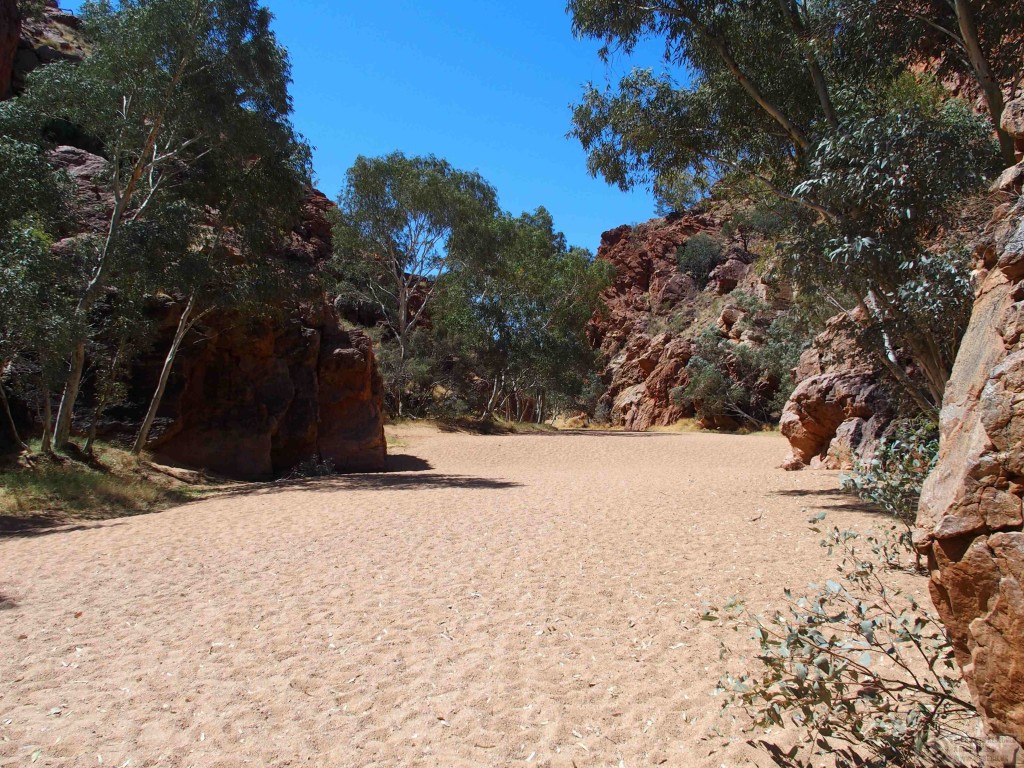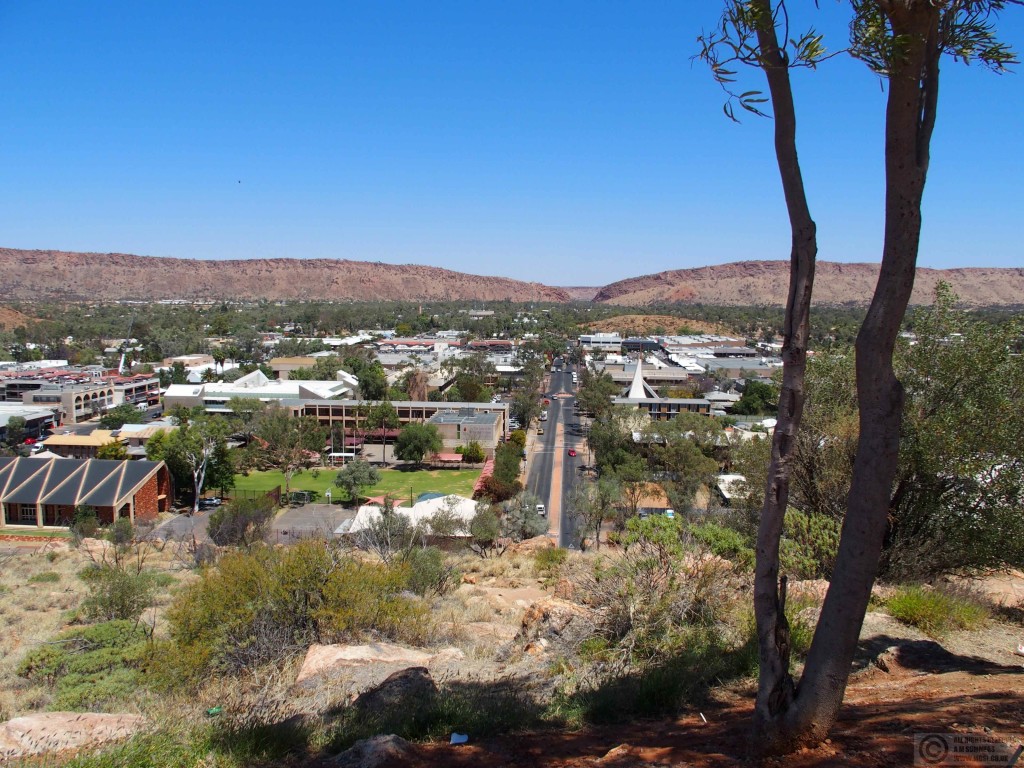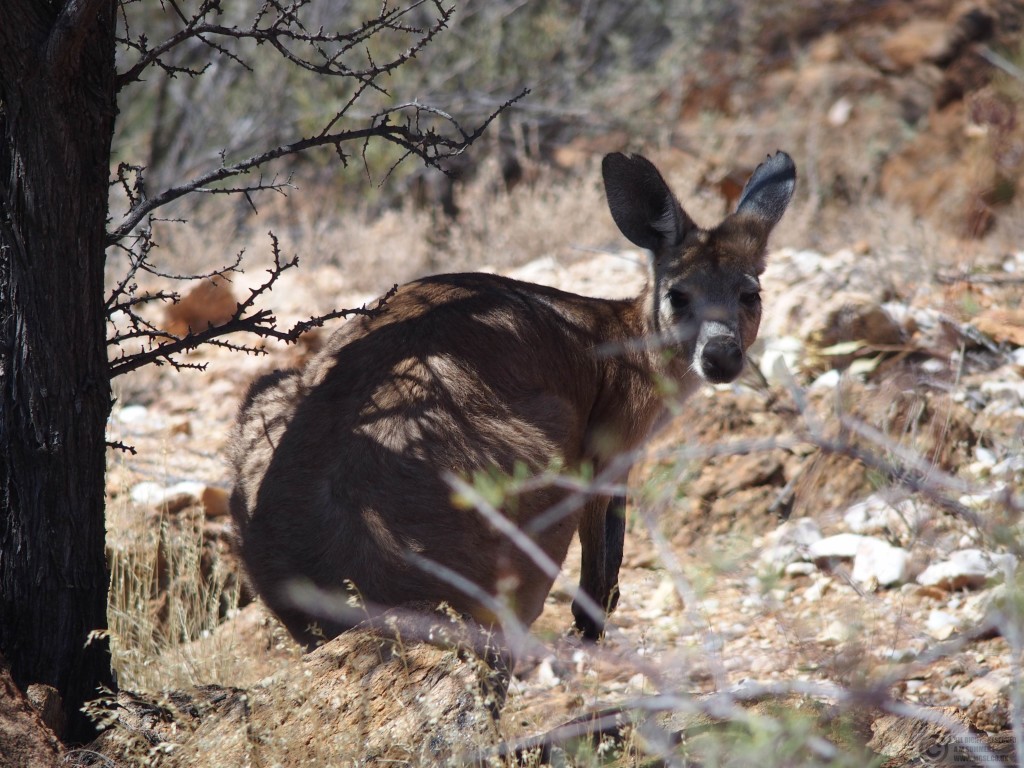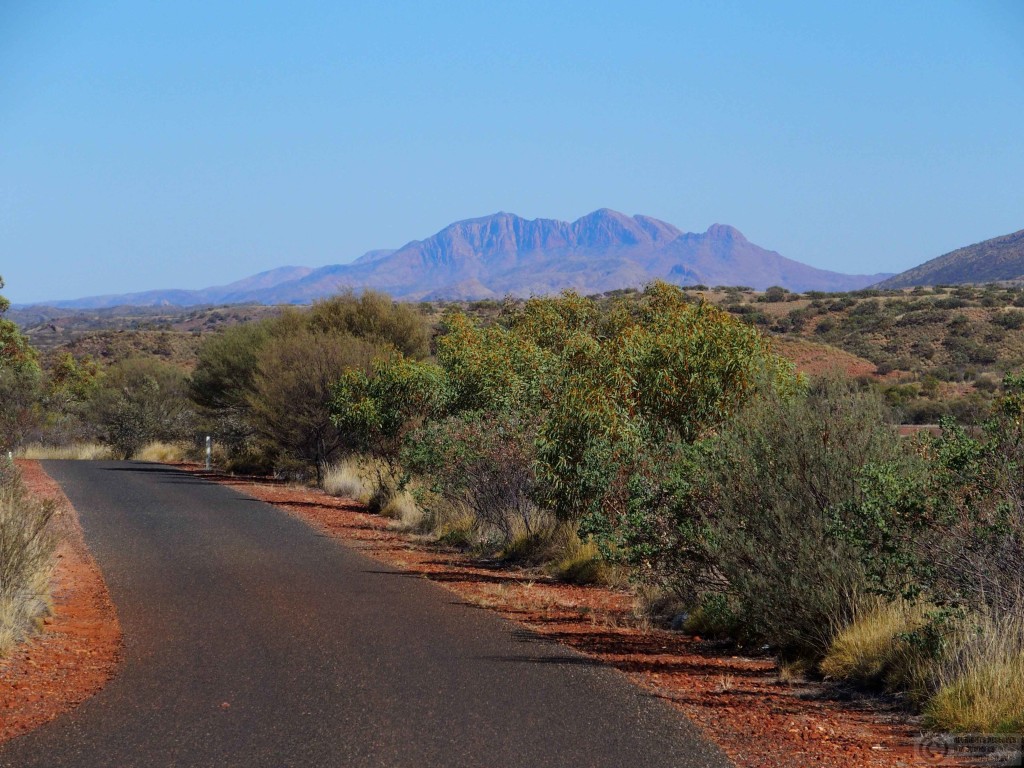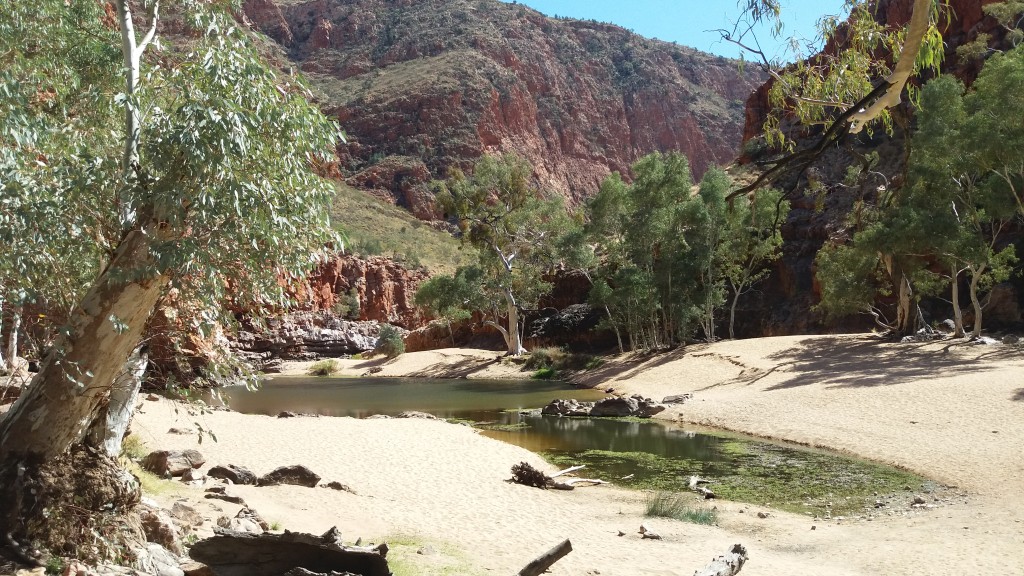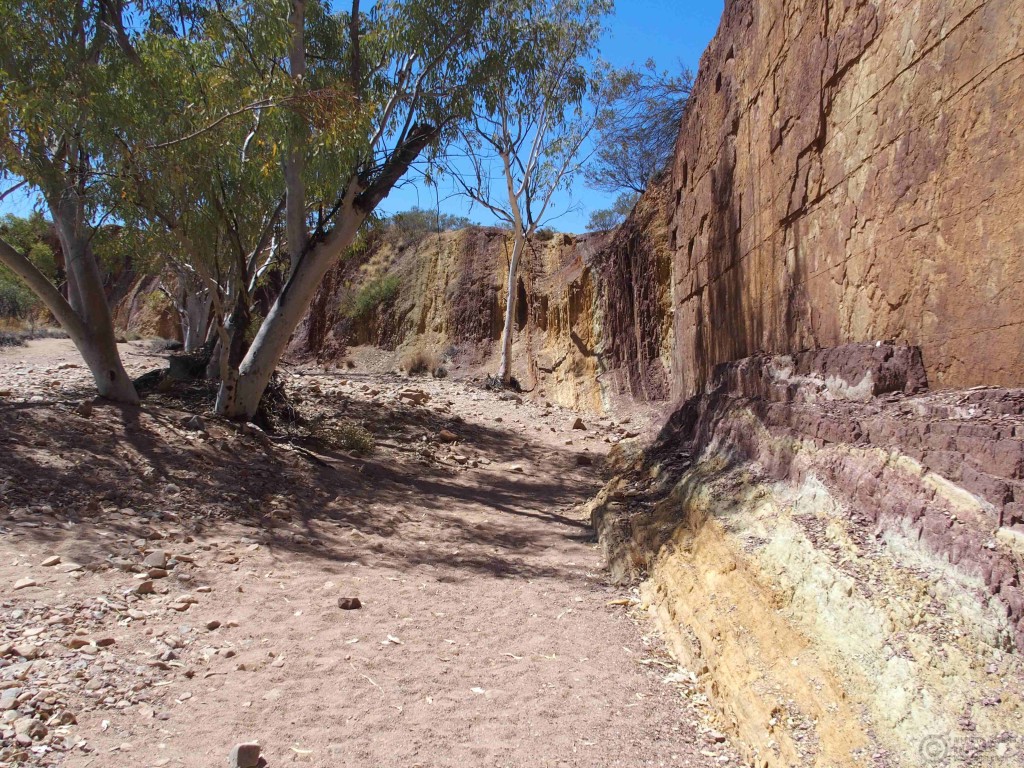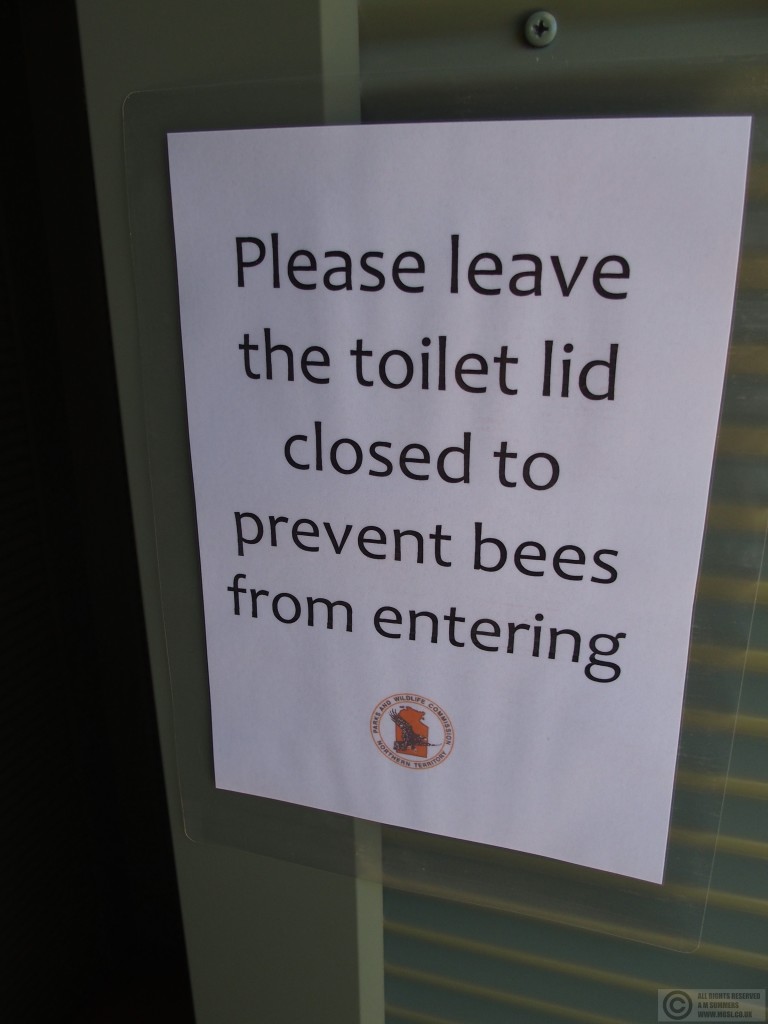The flight to Alice Springs was only about 10% full so our bags came quickly, and the shuttle bus was parked just outside the airport door. Alice Springs is not the biggest of airports, but it was smart and modern.
As it was only 11:00am our hotel room wasn’t ready, so we walked across the Todd River bridge into town. The river bed was wide and sandy – according to the driver of the airport shuttle no rain had fallen for 7 months, so it had dried up long ago. Strolling around the grid of streets in the town centre, it seemed much busier than Darwin, even though Alice has a fifth of Darwin’s population. Whereas the few aborigines we saw in Darwin centre were just sitting in groups in the shade, those here were walking around, chatting and shopping – but still not visible among the shops’ employees, even though they account for almost 20% of Alices’s population.
We went into Woolworths (the Australian equivalent of Sainsbury’s, if the adverts starring Jamie Oliver are anything to go by) looking for a wine box (or ”cask”, in Oz-speak). We didn’t find one as the alcohol section was closed until 2:00pm, but we did find stilton. Real, genuine and affordable stilton – the first since leaving the UK. That was dinner sorted then!
The sign in BWS (the off licence attached to Woolworths) said that wine boxes could only be purchased after 6:00pm, so as the sun was setting we walked back into town – only to find that they didn’t actually sell them at all. Nor did Liquorland in Coles. Apparently if you want a wine box in Alice Springs you need to go to a drive-through bottle shop, whatever that is. So we made do with a bottle of shiraz. It seemed expensive compared with what we had paid for boxes, but actually it was still less than £4 for a bottle.
The hire car that we collected the next morning was another Yaris, but a much older version than the one we’d had in Darwin, and covered in stone chips. We hadn’t commented and didn’t really care, but the guy gave us an extra 50km a day on our allowance because it was so dirty.
As it was a 2WD we could only take it on sealed roads, which meant that some of the sights were inaccessible – but there were plenty that were. Our first destination was the East McDonnell range, and we drove straight to the end. There was more vegetation than I expected, and it was greener. But it was different from Kakadu – the trees were smaller, more varied, more widely spaced, the grass shorter and sparser. You could see much further even on level ground.
The end of the tarmac on the Ross Highway was at Ross River, 85km east of Alice. There was a petrol station and caravan park, the latter advertising conference facilities. It seemed a long way to go for a meeting, but I suppose it reduced the risk of interruption.
Jessie Gap was just a dry chasm – water obviously flowed at times, but not so late in the dry season. Emily Gap was similar but adorned with aboriginal ochre paintings of stylised caterpillars – although I wouldn’t have known that’s what they were without the interpretive signs.
The next morning we set out from the hotel with the intention of seeing the sights in the West Mcdonnell range, but then realised that we didn’t have enough petrol – having the air conditioning on meant the fuel gauge moved very quickly, but turning it off really wasn’t an option. So we viewed Simpson’s Gap, another gorge but this time with water still standing in the bottom. Unfortunately the sun was too high for the local rock wallabies to be active.
Back in town, we headed for the top of Anzac Hill, a site that serves the dual purpose of commemorating Australia’s fallen military personnel and providing a view over Alice Springs.
The Olive Pink Botanical Garden contained a selection of acacias and eucalylipts and was a pleasant place for a wander. It also seemed to be home to a number of wallabies – I’m not sure if they were larger than those in Darwin, or if we were just closer to them.
When we got back to our hotel we found that housekeeping had left the door open – not just unlocked, actually propped open. I suppose it’s easily done, but we could have lost everything.
That evening we dined in the hotel restaurant, our first restaurant meal since landing in Australia. We didn’t order a drink, but it seemed that this was quite normal and we were immediately offered “table water” – in other words, chilled tap water in a fancy bottle. But there was none of the snootiness that would probably have been forthcoming in a British restaurant of similar standard.
With a full tank of petrol, we headed west again very early the next morning. The light was pretty, but we still didn’t see any wallabies, rock or otherwise. Ormiston Gorge was even more picturesque than the others we’d seen, perhaps because it held more water – blue sky, red cliffs, and white and green ghost gums made for striking scenes.
There was no water at the Ochre Pits, just a river of sand. Hues of red, yellow and white striped the low cliffs – all the colours that indigenous Australians use on themselves and their rock paintings.
As we returned to the hotel quite early I considered going for a swim, but the pool was suspiciously empty, and a quick dabble with my fingers told me why. Alice might have warmed up since the 3°C lows of the previous week, but the pool was still catching up.
Lack of cooking facilities isn’t necessarily a bar to a decent in-room dinner if you have a fridge, kettle and western standard supermarkets, so we dined on instant couscous, hot-smoked salmon fillets and tomatoes. It was pretty good for a cheap meal.
As our flight wasn’t until 17:00 we had quite a bit of time to kill after checking out the next day, so we headed for the Tanami Track. Eventually this road leads to somewhere in Western Australia and mostly it’s unsurfaced and incredibly remote – the kind of road for which you need a 4WD and containers of fuel and water. However, the first 120km from Alice are surfaced and accessible by 2WD. Not that there’s much to see – but that was the attraction: a taste of the vastness and emptiness of central Australia. Flat plains, scrubby trees, red earth, and very few other vehicles – and of course, no mobile phone signal. Even on our short foray along the sealed section I would have been uncomfortable without a couple of bottles of water in the car. There was plenty of bird life though, and a fat lizard up a tree which froze at our approach.
Back on the Stuart Highway we turned north for the few kilometers to a cairn marking the highest point between Adelaide and Darwin, and a little further was the Tropic of Capricorn. This was the second time we’d stood on such a marker (the first time being in Madagascar in 1992) – a feat we’ve never managed for any of the other important circles of latitude, although we did cross the Tropic of Cancer by train in China.
There was still a little time to spare when we got back to Alice, so we drove the road that loops from south of the Heavitree Gap, through Ilparpa to Larapinta Drive via the Honeymoon Gap. On the way back into town we stopped at the small Museum of Central Australia which had a good section of meteorites, a local speciality.
The departure lounge at Alice Springs airport was almost deserted when we arrived, so we settled into comfortable chairs with a shared cappuccino. Although Australia is generally quite expensive, at least they don’t seem to price-gouge in airports – the coffee cost $4, which seems to be the cheapest it costs anywhere.
People might be surprised that we didn’t go to Uluru (Ayers Rock) from Alice Springs. It is, after all, Australia’s most iconic landmark, and we were in the neighbourhood. Well, kind of. It’s actually a 4-5 hour drive each way from Alice Springs to Uluru – Newcastle is closer to London than Uluru is to Alice Springs. We could have avoided the 10 hours of driving by flying both ways, or flown on to Cairns from Uluru, but flights are expensive, one way car hire extortionate, and one company controls all the accommodation and eating places at Uluru. With excess mileage and petrol costs we estimated the cost of a 2-night stop as over £500, even if we drove both ways – given that we had no desire to climb it and photography is restricted at many of the most interesting bits, we decided it just wasn’t worth it.



